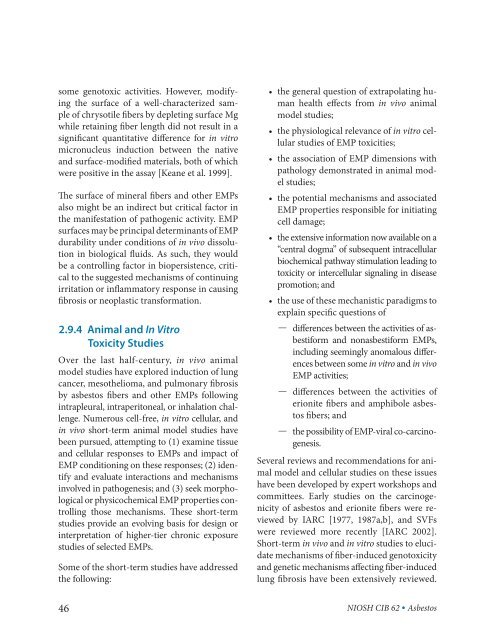Asbestos Fibers and Other Elongate Mineral Particles: State of the ...
Asbestos Fibers and Other Elongate Mineral Particles: State of the ...
Asbestos Fibers and Other Elongate Mineral Particles: State of the ...
- No tags were found...
Create successful ePaper yourself
Turn your PDF publications into a flip-book with our unique Google optimized e-Paper software.
some genotoxic activities. However, modifying<br />
<strong>the</strong> surface <strong>of</strong> a well-characterized sample<br />
<strong>of</strong> chrysotile fibers by depleting surface Mg<br />
while retaining fiber length did not result in a<br />
significant quantitative difference for in vitro<br />
micronucleus induction between <strong>the</strong> native<br />
<strong>and</strong> surface-modified materials, both <strong>of</strong> which<br />
were positive in <strong>the</strong> assay [Keane et al. 1999].<br />
The surface <strong>of</strong> mineral fibers <strong>and</strong> o<strong>the</strong>r EMPs<br />
also might be an indirect but critical factor in<br />
<strong>the</strong> manifestation <strong>of</strong> pathogenic activity. EMP<br />
surfaces may be principal determinants <strong>of</strong> EMP<br />
durability under conditions <strong>of</strong> in vivo dissolution<br />
in biological fluids. As such, <strong>the</strong>y would<br />
be a controlling factor in biopersistence, critical<br />
to <strong>the</strong> suggested mechanisms <strong>of</strong> continuing<br />
irritation or inflammatory response in causing<br />
fibrosis or neoplastic transformation.<br />
2.9.4 Animal <strong>and</strong> In Vitro<br />
Toxicity Studies<br />
Over <strong>the</strong> last half-century, in vivo animal<br />
model studies have explored induction <strong>of</strong> lung<br />
cancer, meso<strong>the</strong>lioma, <strong>and</strong> pulmonary fibrosis<br />
by asbestos fibers <strong>and</strong> o<strong>the</strong>r EMPs following<br />
intrapleural, intraperitoneal, or inhalation challenge.<br />
Numerous cell-free, in vitro cellular, <strong>and</strong><br />
in vivo short-term animal model studies have<br />
been pursued, attempting to (1) examine tissue<br />
<strong>and</strong> cellular responses to EMPs <strong>and</strong> impact <strong>of</strong><br />
EMP conditioning on <strong>the</strong>se responses; (2) identify<br />
<strong>and</strong> evaluate interactions <strong>and</strong> mechanisms<br />
involved in pathogenesis; <strong>and</strong> (3) seek morphological<br />
or physicochemical EMP properties controlling<br />
those mechanisms. These short-term<br />
studies provide an evolving basis for design or<br />
interpretation <strong>of</strong> higher- tier chronic exposure<br />
studies <strong>of</strong> selected EMPs.<br />
Some <strong>of</strong> <strong>the</strong> short-term studies have addressed<br />
<strong>the</strong> following:<br />
46<br />
• <strong>the</strong> general question <strong>of</strong> extrapolating human<br />
health effects from in vivo animal<br />
model studies;<br />
• <strong>the</strong> physiological relevance <strong>of</strong> in vitro cellular<br />
studies <strong>of</strong> EMP toxicities;<br />
• <strong>the</strong> association <strong>of</strong> EMP dimensions with<br />
pathology demonstrated in animal model<br />
studies;<br />
• <strong>the</strong> potential mechanisms <strong>and</strong> associated<br />
EMP properties responsible for initiating<br />
cell damage;<br />
• <strong>the</strong> extensive information now available on a<br />
“central dogma” <strong>of</strong> subsequent intracellular<br />
biochemical pathway stimulation leading to<br />
toxicity or intercellular signaling in disease<br />
promotion; <strong>and</strong><br />
• <strong>the</strong> use <strong>of</strong> <strong>the</strong>se mechanistic paradigms to<br />
explain specific questions <strong>of</strong><br />
ȣ differences between <strong>the</strong> activities <strong>of</strong> asbesti<br />
form <strong>and</strong> nonasbestiform EMPs,<br />
including seemingly anomalous differences<br />
between some in vitro <strong>and</strong> in vivo<br />
EMP activities;<br />
ȣ differences between <strong>the</strong> activities <strong>of</strong><br />
erionite fibers <strong>and</strong> amphibole asbestos<br />
fibers; <strong>and</strong><br />
ȣ <strong>the</strong> possibility <strong>of</strong> EMP-viral co-carcinogenesis.<br />
Several reviews <strong>and</strong> recommendations for animal<br />
model <strong>and</strong> cellular studies on <strong>the</strong>se issues<br />
have been developed by expert workshops <strong>and</strong><br />
committees. Early studies on <strong>the</strong> carcinogenicity<br />
<strong>of</strong> asbestos <strong>and</strong> erionite fibers were reviewed<br />
by IARC [1977, 1987a,b], <strong>and</strong> SVFs<br />
were reviewed more recently [IARC 2002].<br />
Short-term in vivo <strong>and</strong> in vitro studies to elucidate<br />
mechanisms <strong>of</strong> fiber-induced genotoxicity<br />
<strong>and</strong> genetic mechanisms affecting fiber-induced<br />
lung fibrosis have been extensively reviewed.<br />
NIOSH CIB 62 • <strong>Asbestos</strong>

















